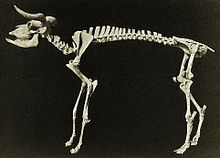The shrub-ox (Euceratherium collinum) is an extinct species of ovibovine caprine native to North America and China during the Pleistocene epoch. It was the only species in the genus Euceratherium.
| Shrub-ox Temporal range: Early Pleistocene to Late Pleistocene
| |
|---|---|

| |
| Restoration | |
| Scientific classification | |
| Domain: | Eukaryota |
| Kingdom: | Animalia |
| Phylum: | Chordata |
| Class: | Mammalia |
| Order: | Artiodactyla |
| Family: | Bovidae |
| Subfamily: | Caprinae |
| Tribe: | Ovibovini |
| Genus: | †Euceratherium Furlong & Sinclair, 1904 |
| Species: | †E. collinum
|
| Binomial name | |
| †Euceratherium collinum Furlong & Sinclair, 1904
| |
| Synonyms | |
|
Genus level:
Species level:
| |


Taxonomy
editEuceratherium was formally described in 1904.[1] The species is considered to be closely related to the living muskox, as well as extinct genera like Bootherium.[2]
Distribution
editThe earliest fossils of the genus are known from the Early Pleistocene of China, from which it is then suggested to have migrated into North America.[2]
Late Pleistocene shrub-ox remains are known from fossil finds spanning from what is now northern California to central Mexico. In the east of their range, they were distributed at least into Illinois.
Description
editEuceratherium has been estimated to weight approximately 450 kilograms (990 lb).[3]
Ecology
editOn the basis of preserved dung pellets, it has been established that they were browsers with a diet of trees and shrubs.[4] They seem to have preferred hilly landscapes.
References
edit- ^ Furlong, E. L. & Sinclair, W. J. (1904). Preliminary description of Euceratherium collinum. University of California Publications, American Archaeology and Ethnology, 2:18.
- ^ a b Bai, Weipeng; Dong, Wei; Zhang, Limin (July 15, 2024). "The first confirmation of North American extinct shrub-ox (Euceratherium, Artiodactyla, Mammalia) in the Early Pleistocene of northern China". Quaternary Science Reviews. 336: 108777. doi:10.1016/j.quascirev.2024.108777.
- ^ Smith, Felisa A.; Elliott Smith, Rosemary E.; Lyons, S. Kathleen; Payne, Jonathan L. (2018-04-20). "Body size downgrading of mammals over the late Quaternary". Science. 360 (6386): 310–313. doi:10.1126/science.aao5987. ISSN 0036-8075.
- ^ Kropf, M.; Mead, J. I.; Anderson, R. S. (January 2007). "Dung, diet, and the paleoenvironment of the extinct shrub-ox (Euceratherium collinum) on the Colorado Plateau, USA". Quaternary Research. 67 (1). Elsevier: 143–151. Bibcode:2007QuRes..67..143K. doi:10.1016/j.yqres.2006.10.002. Accessed 2008-08-19.
Further reading
edit- P. S. Martin: Quaternary Extinctions. The University of Arizona Press, 1984 ISBN 0-8165-1100-4
- Grundzüge der Faunen- und Verbreitungsgeschichte der Säugetiere, E. Thenius, 2.Auflage, Gustav Fischer Verlag, Stuttgart, 1980 ISBN 3-437-30312-0
External links
edit